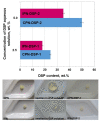Conceptualization and Investigation of Multicomponent Polymer Networks as Prospective Corticosteroid Carriers
- PMID: 37367141
- PMCID: PMC10298209
- DOI: 10.3390/gels9060470
Conceptualization and Investigation of Multicomponent Polymer Networks as Prospective Corticosteroid Carriers
Abstract
Dexamethasone (DXM) is a highly potent and long-acting synthetic glucocorticoid with anti-inflammatory, anti-allergic, and immunosuppressive effects. However, the systemic application of DXM can cause undesirable side effects: sleep disorders, nervousness, heart rhythm disorders, heart attack, and others. In the present study, multicomponent polymer networks were developed as potential new platforms for the dermal application of dexamethasone sodium phosphate (DSP). First, a copolymer network (CPN) comprising hydrophilic segments of different chemical structures was synthesized by applying redox polymerization of dimethyl acrylamide onto poly(ethylene glycol) in the presence of poly(ethylene glycol) diacrylate (PEGDA) as a crosslinker. On this basis, an interpenetrating polymer network structure (IPN) was obtained by introducing a second network of PEGDA-crosslinked poly(N-isopropylacrylamide). Multicomponent networks obtained were characterized by FTIR, TGA, and swelling kinetics in different solvents. Both CPN and IPN showed a high swelling degree in aqueous media (up to 1800 and 1200%, respectively), reaching the equilibrium swelling within 24 h. Additionally, IPN showed temperature-responsive swelling in an aqueous solution as the equilibrium swelling degree decreased considerably with an increase in the temperature. In order to evaluate the networks' potential as drug carriers, swelling in DSP aqueous solutions of varied concentration was investigated. It was established that the amount of encapsulated DSP could be easily controlled by the concentration of drug aqueous solution. In vitro DSP release was studied in buffer solution (BS) with pH 7.4 at 37 °C. The results obtained during DSP loading and release experiments proved the feasibility of the developed multicomponent hydrophilic polymer networks as effective platforms for potential dermal application.
Keywords: copolymer network; dermal application; dexamethasone sodium phosphate; drug delivery; interpenetrating network.
Conflict of interest statement
The authors declare no conflict of interest.
Figures








Similar articles
-
Interpenetrating Polymer Networks of Poly(2-hydroxyethyl methacrylate) and Poly(N, N-dimethylacrylamide) as Potential Systems for Dermal Delivery of Dexamethasone Phosphate.Pharmaceutics. 2023 Sep 15;15(9):2328. doi: 10.3390/pharmaceutics15092328. Pharmaceutics. 2023. PMID: 37765296 Free PMC article.
-
In Vitro and In Vivo Evaluation of Hydroxypropyl-β-cyclodextrin-grafted-poly(acrylic acid)/poly(vinyl pyrrolidone) Semi-Interpenetrating Matrices of Dexamethasone Sodium Phosphate.Pharmaceuticals (Basel). 2022 Nov 14;15(11):1399. doi: 10.3390/ph15111399. Pharmaceuticals (Basel). 2022. PMID: 36422529 Free PMC article.
-
Analysis of poly(ethylene glycol)-diacrylate macromer polymerization within a multicomponent semi-interpenetrating polymer network system.J Biomed Mater Res A. 2004 Dec 1;71(3):508-18. doi: 10.1002/jbm.a.30179. J Biomed Mater Res A. 2004. PMID: 15386483
-
Smart Macroporous IPN Hydrogels Responsive to pH, Temperature, and Ionic Strength: Synthesis, Characterization, and Evaluation of Controlled Release of Drugs.ACS Appl Mater Interfaces. 2016 May 18;8(19):12018-30. doi: 10.1021/acsami.6b02264. Epub 2016 May 4. ACS Appl Mater Interfaces. 2016. PMID: 27115698
-
Crosslinked ionic polysaccharides for stimuli-sensitive drug delivery.Adv Drug Deliv Rev. 2013 Aug;65(9):1148-71. doi: 10.1016/j.addr.2013.04.016. Epub 2013 Apr 29. Adv Drug Deliv Rev. 2013. PMID: 23639519 Review.
Cited by
-
Interpenetrating Polymer Networks of Poly(2-hydroxyethyl methacrylate) and Poly(N, N-dimethylacrylamide) as Potential Systems for Dermal Delivery of Dexamethasone Phosphate.Pharmaceutics. 2023 Sep 15;15(9):2328. doi: 10.3390/pharmaceutics15092328. Pharmaceutics. 2023. PMID: 37765296 Free PMC article.
-
Hydrogels of Poly(2-hydroxyethyl methacrylate) and Poly(N,N-dimethylacrylamide) Interpenetrating Polymer Networks as Dermal Delivery Systems for Dexamethasone.Pharmaceutics. 2025 Jan 5;17(1):62. doi: 10.3390/pharmaceutics17010062. Pharmaceutics. 2025. PMID: 39861710 Free PMC article.
References
-
- Yasir M., Goyal A., Sonthalia S. StatPearls. StatPearls Publishing; Treasure Island, FL, USA: 2022. Corticosteroid Adverse Effects. - PubMed
-
- European Medicines Agency . Assessment Report of Dexamethasone Alapis. European Medicines Agency; Amsterdam, The Netherlands: 2011.
Grants and funding
LinkOut - more resources
Full Text Sources
Miscellaneous

